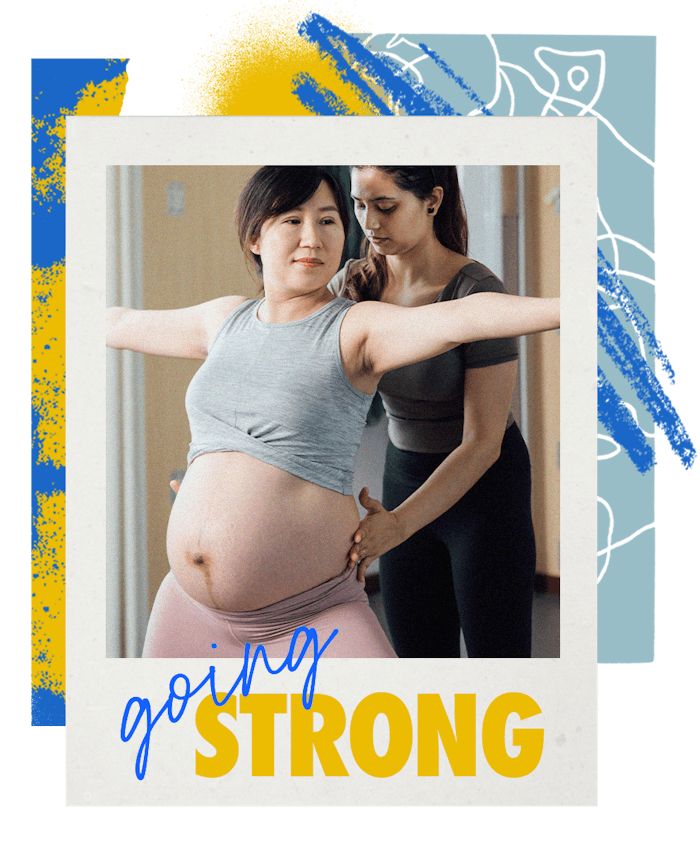Going Strong

I’m A Postpartum Fitness Instructor & Still Felt Bad About My Body — Here’s How I Overcame That
Let your body be as big as it needs to be.
My third pregnancy was supposed to be different. I’ve been pregnant three times and each time my body did basically the exact same thing: grew size G boobs overnight and craved only white food with a side of white condiments. The big difference, though, was that my second and third pregnancies were 10 years apart and during that decade, I had dedicated my entire career to postpartum rehabilitation and functional strength.
In other words, before my last pregnancy, I was stronger than I had ever been in my life. As a result, I’d convinced myself that I would be a glowy, properly-proportioned pregnant person (whatever that means). I decided that my fitness would magically override my, you know, hormones and genetics.
That is not what happened. No, my body did the beautiful thing it is designed to do: It gathered the resources it needed to grow a human inside it.
As a result, though, I felt an urge to hide — a fact I hate admitting because my work is all about helping new mothers focus on what their bodies can do instead of what they look like. Yet there I was, more aware of and more amazed by what my body had accomplished — and I still felt icky about how it all looked and felt. I felt like a fraud: a prenatal and postpartum fitness instructor who preached body positivity but was filled with angst about her own body.
I had to remind myself that I can accept my body’s ever-changing shape, while at the same time accepting that I don’t always feel great about how it looks. Living in the tension between this lets me revere what my body can do. In my experience, this mindset requires a process of unlearning everything we have been taught about the mothering body. When my body changes, am I still desirable? Am I still valuable? I have only been able to answer these questions by challenging the status quo — and then discovering that nothing terrible happens when I do.
I can accept my body’s ever-changing shape, while also accepting that I don’t always feel great about how it looks.
All of this can get a little heady, and I’ve found it helpful to come back to some concrete, body-focused lessons — namely, something called proprioception, or the nervous system’s awareness of your body and its surroundings. When you walk through a door and know there is a ledge to step over, or when you duck as your kid throws a frisbee the wrong way, these are examples of proprioception.
Interestingly, the more limited and contained our movement becomes, the more static this proprioception gets. Take, for example, a person who begins to shuffle their feet when walking after experiencing a fall. During the recovery period of that injury, the nervous system was focused on protecting from further injury, which meant limiting the range of movement in certain areas. That’s an important temporary response.
The key word here is “temporary”: eventually, we’ll need to let the nervous system know that we’re no longer in danger. This means carefully starting to pick up our feet and shift our weight as we walk. At first, yes, our nervous system will be a little shocked. But with practice and with time, the nervous system will agree that the threat is gone. This new, less restrictive movement is safe.
As an experiment, go outside later and do a somersault (ahem, on a soft surface). Unless you are a gymnast or a consistent somersaulter, you will feel dizzy and everything in your body will scream, danger danger. It’s because you challenged your proprioceptive nervous system; you moved in ways your body is not used to moving. But if you can do that every day, even for just a few days, you’ll soon find that the dizziness dissipates, and the danger cues dull to a whisper.
It gets easier, in other words.
We can find new ways to secure our value, not by controlling our bodies but instead using them to do exciting things in the world. And when we do this, we often discover that we are surrounded by other strong people who are willing to expand, but who also make room for you to be exactly you. This is the beauty of what happens when we let ourselves be mothers whose bodies show motherhood, on whatever terms the body wants.
Going Strong is Romper’s column on motherhood and moving your body by personal trainer Courtney Wyckoff, founder of MommaStrong.